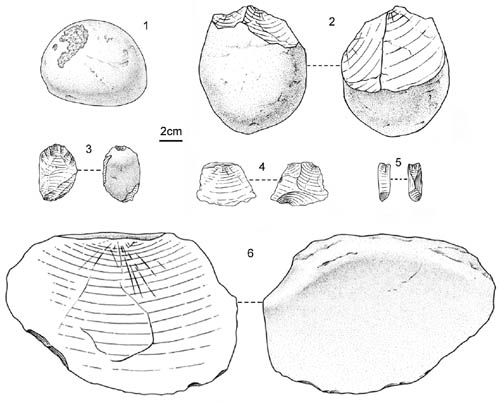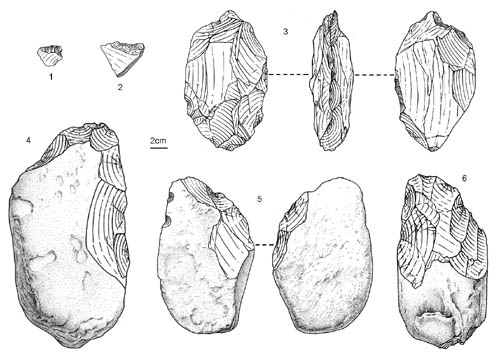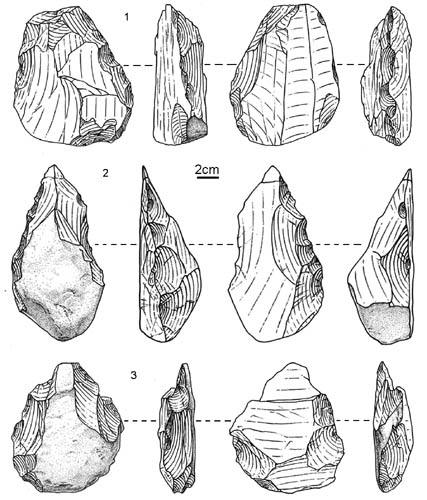Danjiangkou reservoir is located in the northwest of Hubei Province and southwest of Henan Province at the headwaters area of the Middle Route of the South-to-North Water Transfer Project. In 1994 and 2004, Scientists from the Institute of Vertebrate Paleontology and Paleoanthropology (IVPP), Chinese Academy of Sciences, conducted two surveys around the margin of the Danjiangkou reservoir that will later be submerged upon completing a new section of the dam, and found 91 paleolithic open-air sites, distributed upon different terraces along the Hanshui River and its tributary Danjiang River. In April and May 2009, researchers carried out an excavation in the Guochachang II site which is located on the left bank of Hanshui River’s third terrace. The excavation exposed an area of 500 m
2 and uncovered 132 stone artifacts in situ as reported in the latest issue of
Acta Anthropologica Sinica 2013 (2).
The Danjiangkou reservoir area is a pivotal region for human migration and cultural communication between south and north China. The discovery of hominid fossils, such as Xichuan Man, Yunyang Man, Meipu Man, Yunxian Man, and abundant Paleolithic sites in this area highlight its significant position in the Paleoanthropology and Paleolithic archaeology of China.
The excavated lithic assemblage in the Guochachang II site includes hammerstones (9), cores (14), flakes (69), chunks (18), and stone tools (22). Stone tools include scrapers (13), choppers (5), picks (1), and handaxes (3).
The typology and technological analysis of these stone artifacts reveals that lithic raw materials were locally available from ancient river gravels. Four kinds of raw materials were utilized: quartz, siliceous limestone, tuff and sandstone. Quartz is dominant for hammerstones, cores, flakes and chunks. Scarpers were predominantly made on quartz, but the heavy-duty tools mainly employed siliceous limestone and tuff.
The principal flaking techniques are direct hard hammer freehand percussion and bipolar percussion. Meanwhile, the anvil technique was possibly used also. Flakes struck with the anvil technique are large in size, with heavier weights and large platform angles, compared with the bipolar and freehand flakes. Freehand cores (85.71%) and bipolar percussion cores are dominated by simple core reduction strategies (single and double-platform cores=75%), and the multi-platform cores comprise 25%.
Scrapers mainly employed small flake blanks (<50mm), with minimal unifacial retouch. For the heavy-duty tools, large cobbles were the predominant blank for choppers and picks. However, all the handaxes were made on large flakes with bifacial shaping.
There were three different methods for the tools making in this site: 1) a reduction sequence for small-sized flakes and light-duty tools; 2) a sequence of making heavy-duty tools based on large-sized cobbles; 3) and the production of large flake blanks for heavy-duty tools.
The cultural layer in the Guochachang II site can be generally divided into two parts, a upper layer with calcareous nodules and a lower layer of grey-white vermiculated soil. Based on the geomorphology and the nature of the sediments, researchers suggested that the date of this site should be Middle Pleistocene, close to the S4-S5 in the loesspaleosol sequence.
“The study on the Guochachang II site provides us very important data for understanding the early Paleolithic culture in the Danjiangkou Reservoir area, and for exploring the adaptive strategy and the behavioral pattern of the early humans who lived in the Danjiangkou reservoir area”, said project leader LI Chaorong of the IVPP.
This work was mainly supported by National Natural Science Foundation of China and Key Program for International S & T Cooperation Projects of China.

Fig.1 Hammerstone (1), cores (2, 3) and flakes (4-6) from the Guochachang II site of the Danjiangkou Reservoir area. (Image by XU Yong)

Fig.2 Scrapers (1,2), choppers (3-5) and pick (6) from the Guochachang II site of the Danjiangkou Reservoir Area. (Image by XU Yong)

Fig.3 Handaxes from the Guochachang II site of the Danjiangkou Reservoir Area. (Image by XU Yong)


